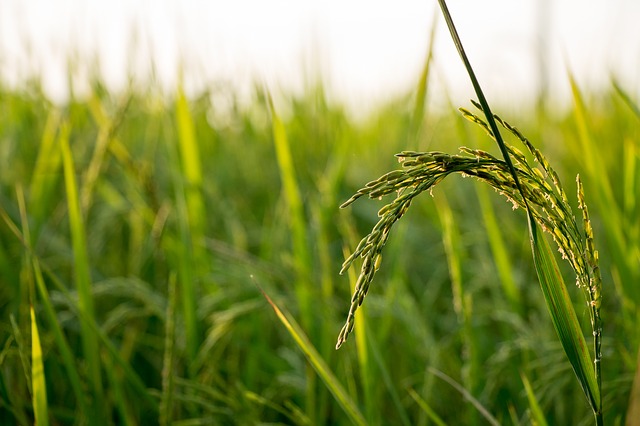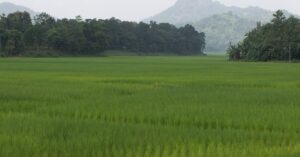By the end of October, a yellow sea will engulf the paddy fields of Meghalaya stretching from one end of the field, broken only by the low hills themselves covered with lush green vegetation. Anyone looking at this vista will not be wrong to presume that this represents a perfect example of traditional monoculture, where one single crop dominates the food production system. Industrial farming is characterised by monoculture and this has been cited as being a drawback of the system. Monoculture (focus on a single crop) combined with the excessive use of chemical fertilizers to sustain it has been responsible for the exhaustion of soil nutrients, increases vulnerability to pests and diseases, depleting water table, and pollution from harmful chemicals. Therefore, looking from this perspective, it would appear that the Indigenous Food System (IFS), which is based on paddy cultivation, should also suffer from the same drawbacks. Indeed this might have been the case but biodiversity, which is the fulcrum of IFS, is very much present in the indigenous paddy-based food production system of the indigenous communities of Meghalaya.
On March 13, 2019, as part of the Rural Electrification Corporation (REC) supported project “No One Shall Be Left Behind: Biodiversity for Food, Nutrition and Energy Security, Meghalaya and Nagaland, North East India”, the North East Slow Food and Agrobiodiversity Society (NESFAS) organised a Rice Festival in Liarsluid (Ri-Bhoi) where farmers from Ri-Bhoi, West Khasi Hills, East Khasi Hills, and Jaintia Hills arrived to take part in the event. An important program in this gathering was a Focus Group Discussion (FGD) with the farmers on the best practices concerning rice cultivation that exists in different areas and the problems that plague them. A free listing was also done of the various rice varieties grown by farmers and the benefits derived from the plots on which they are grown. Surprisingly, it was found that apart from rice, the paddy fields also supported vegetables (wild and cultivated), fruit trees, and various animals: rodents, insects, amphibians, and various species of fish. Rice was not the only bio-resource found in this system. The paddy fields, in fact, harbored a rich source of biological diversity.
Even in terms of rice, diversity was a recurring feature. The minimum number of rice varieties (four) was reported by farmers from East and West Khasi Hills while the maximum (28) was from Ri-Bhoi. Though the number of varieties grown by an individual farmer has not been assessed, the fact that every third year, a farmer rotates a variety with a new one suggests that a minimum of two varieties must be available in a single household. This number might be more for farmers from Ri Bhoi who may have at least half a dozen planted in their plots. Such varieties will have varying nutritional content, resilience to pest and disease, adaptation potential to climate change and culinary attributes. Some of the varieties recorded are, viz., khaw mynri, lakang, jwain, manipur, laispah, joha, lang mai, skuin, nari, pnah mawtawar, pnah latara, phan ther, etc. So while only a single crop dominates there is a great amount of intra-species diversity which makes it different from the industrial monoculture which concentrates only on a single variety at a time. In the indigenous paddy based IFS diversity, instead, is an essential attribute.
Rice is sown during the onset of the Monsoon season and is harvested in November-December. In some cases, the land is kept fallow during the intervening period. But the farmers who took part in the FGD reported growing vegetables in the same plots after the harvest. The highest number of vegetables (26) was recorded from the paddy fields in Ri Bhoi while the lowest number (4) was from East and West Khasi Hills. Some of the important vegetables are potato, pumpkin, carrot, beet, onion, tomato, french beans, and beans. These are sown during January-February and are harvested in June, just before paddy sowing season commences. Among the various vegetables, beans are an important food plant. Being part of the legume family, beans fix the atmospheric nitrogen, release into the soil high-quality organic matter and facilitate soil nutrients’ circulation and water retention. In short, they help in replenishing the soil and getting it ready for the new planting season. At the same, these vegetables are an important source of micro-nutrients helping in diversifying the household diet.

Another category of vegetables is the wild vegetables that are found in abundance in the paddy fields. These grow on the bunds dividing the plots or along the banks of the stream flowing across the fields. More than a dozen wild vegetables are harvested at different times of the year viz., jatira, tyrsim khlieng, jakseh (Feb-April), khmut sim (Mar-April), latara (Jan-March), jakyrweng (January-Feb), etc, while some like kynbat maloi, jaryndem, thylliej masi are harvested throughout the year. These wild vegetables are an important source of micro nutrients for the community and are especially important when the cultivated crops are not ready to be harvested. In 2018, Lukas Pawera, an ethnobotanist from Czech Republic during his visits to the villages around Bhoirymbong remarked that the wild vegetables found in the paddy fields are similar to those he encountered in Indonesia. However, in his 2020 paper “Wild Food Plants and Trends in Their Use: From Knowledge and Perceptions to Drivers of Change in West Sumatra, Indonesia” he revealed that community members in his study area have reported that intensification accompanied by increased use of chemicals has reduced the availability of wild vegetables. Fruits trees are very few. The highest number (13) of fruit trees was reported by farmers from Jaintia Hills, while no fruit trees were reported from the paddy fields of East and West Khasi Hills. Important fruit trees are sohpriam, sohliya, sama, sohphoh, etc. These grow along the edges of the plots and provide shade for the farmers from the scorching sun as they take a break from their toil.
Finally, there are the various creatures that have made the paddy fields their home. The highest number of animals (28) from the paddy fields was reported from Ri Bhoi while the lowest (nine) is from East and West Khasi Hills. Among the various animals that are harvested for food, rodents like khnai rit, khnai kyntur, amphibians like tham bah, tham saw, insects like nianktung, niangsdei and fishes like dohthli, doh bsein, doh wieh, doh mukur, doh snah are some of the important ones. Fishes are normally caught from the streams that crisscross the paddy fields. During the monsoon season, though, the streams overflow. Fishes are swept into the paddy fields along with the floodwater supplying the much-needed protein to the diet of the farmers who collect them.
In his 2005 paper ‘Biodiversity and nutrition in rice-based aquatic ecosystems’, Matthias Halwart (from FAO, Fisheries and Aquaculture Department) reported that the number of aquatic-based species collected by the communities of South East Asia, which included amphibians, crustaceans, fishes, mollusks, reptiles, and plants, ranged from 37 in Vietnam to 100 in Cambodia. This biodiversity supplies the essential micronutrients that are not (or not adequately) found in rice, particularly calcium, zinc, iron, vitamin A and some fatty acids and limiting amino acids. Development that focuses on rice (industrial monoculture) will reduce biodiversity and take away the benefits associated with it, integrated pest management, improvement in yield among others. Most worryingly it will reduce the nutritional status of the rural communities of Meghalaya.
The indigenous paddy-based IFS, as practised by the indigenous communities of Meghalaya, has sustained them for centuries and can do so for the future. With climate change already upon us, the adaptation solutions could possibly be contained within its biodiversity. But for all that to happen, indigenous paddy based IFS has to be acknowledged for its myriad benefits and should be protected from the onslaught of intensification emanating from the logic of industrial farming. The specter of loss of biodiversity with consequent decrease in the resilience of the indigenous communities among which food insecurity is one of the symptoms await if that does not happen. Hopefully that will not be the future of the indigenous communities of Meghalaya.
About the writers
Bhogtoram Mawroh is a Senior Associate in NESFAS and can be reached at bhogtoram.nesfas@gmail.com
Stefan W Lyndoh is a Research Associate in NESFAS and can be reached at stefan.nesfas@gmail.com
This article has also been published in The Shillong Times





